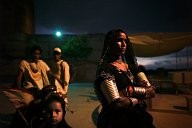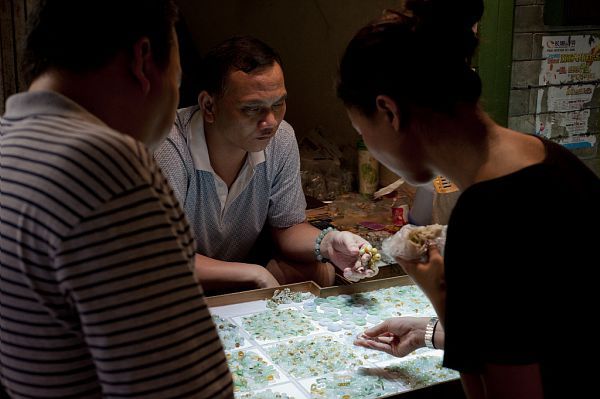Refine search
No keyword found to refine search
keywords EN
Places
Names
28 documents found
| 1 |
Documents per page :
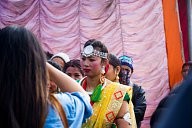
2018, Jan 15 - Maghi festival. New Year of Nepal in Tundikhel through the day. The festival had started from Kathmandu Durbar Square.
Noémie Repetto / Le Pictorium
LePictorium_0173466.jpg
Maghe Sankranti is the first day of the month of Magh of Bikram Sambat. Magh is the tenth month of the year.
Sankranti is the Sanskrit word in Eastern Astrology which refers to the transmigration of the Sun from one Rashi (sign of the zodiac) to another. In very simple, the word sankranti is the first day of the Nepali calendar. Then obviously, there are 12 sankrantis in a year. Makar Sankranti is the transition of the Sun from Dhanu rashi (Sagittarius) to Makara rashi (Capricorn).
In Hindu Astrology the sun position during the year is divided into 12 rashis (zodiac signs). It is however, very difficult to reconcile among Bikram Sambat months, Zodiac months and lunar calendar's months. While the traditional Calendar is based on lunar positions, Sankranti is a solar event. So dates of all Hindu festivals keep changing as per the Gregorian calendar and so do the Makar Sankranti too.
Makar Sankranti is the festival of the Sun God. The Sun God is the symbol of power, divinity and wisdom. The Sun God is worshiped in this festival.
Maghe Sankranti is also called Maghi. Maghi is for the New year of Tharu Community of Nepal.
Sankranti is the Sanskrit word in Eastern Astrology which refers to the transmigration of the Sun from one Rashi (sign of the zodiac) to another. In very simple, the word sankranti is the first day of the Nepali calendar. Then obviously, there are 12 sankrantis in a year. Makar Sankranti is the transition of the Sun from Dhanu rashi (Sagittarius) to Makara rashi (Capricorn).
In Hindu Astrology the sun position during the year is divided into 12 rashis (zodiac signs). It is however, very difficult to reconcile among Bikram Sambat months, Zodiac months and lunar calendar's months. While the traditional Calendar is based on lunar positions, Sankranti is a solar event. So dates of all Hindu festivals keep changing as per the Gregorian calendar and so do the Makar Sankranti too.
Makar Sankranti is the festival of the Sun God. The Sun God is the symbol of power, divinity and wisdom. The Sun God is worshiped in this festival.
Maghe Sankranti is also called Maghi. Maghi is for the New year of Tharu Community of Nepal.
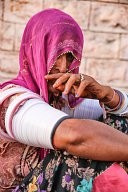
Portraits of women and children of Rajasthan. In the countryside, the women of Rajasthan wear long skirts, a small bolero and veil with bright colors. They adorn themselves with silver jewels ( earrings, nose rings, necklaces, arm and ankle bracelets). They raise the children and participate in the rural works ( cattle, farming, wood and water tasks). Most of the marriages are settled and the place of women is by and at the service of their in-laws.
Sandrine Huet / Le Pictorium
LePictorium_0146602.jpg
Pictures of Rajasthan, portraits and lifestyles
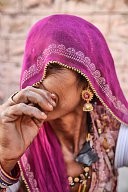
Portraits of women and children of Rajasthan. In the countryside, the women of Rajasthan wear long skirts, a small bolero and veil with bright colors. They adorn themselves with silver jewels ( earrings, nose rings, necklaces, arm and ankle bracelets). They raise the children and participate in the rural works ( cattle, farming, wood and water tasks). Most of the marriages are settled and the place of women is by and at the service of their in-laws.
Sandrine Huet / Le Pictorium
LePictorium_0146603.jpg
Pictures of Rajasthan, portraits and lifestyles
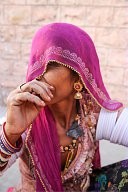
Portraits of women and children of Rajasthan. In the countryside, the women of Rajasthan wear long skirts, a small bolero and veil with bright colors. They adorn themselves with silver jewels ( earrings, nose rings, necklaces, arm and ankle bracelets). They raise the children and participate in the rural works ( cattle, farming, wood and water tasks). Most of the marriages are settled and the place of women is by and at the service of their in-laws.
Sandrine Huet / Le Pictorium
LePictorium_0146604.jpg
Pictures of Rajasthan, portraits and lifestyles

Portraits of women and children of Rajasthan. In the countryside, the women of Rajasthan wear long skirts, a small bolero and veil with bright colors. They adorn themselves with silver jewels ( earrings, nose rings, necklaces, arm and ankle bracelets). They raise the children and participate in the rural works ( cattle, farming, wood and water tasks). Most of the marriages are settled and the place of women is by and at the service of their in-laws.
Sandrine Huet / Le Pictorium
LePictorium_0146606.jpg
Pictures of Rajasthan, portraits and lifestyles
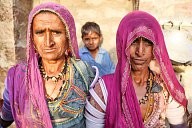
Portraits of women and children of Rajasthan. In the countryside, the women of Rajasthan wear long skirts, a small bolero and veil with bright colors. They adorn themselves with silver jewels ( earrings, nose rings, necklaces, arm and ankle bracelets). They raise the children and participate in the rural works ( cattle, farming, wood and water tasks). Most of the marriages are settled and the place of women is by and at the service of their in-laws.
Sandrine Huet / Le Pictorium
LePictorium_0146607.jpg
Pictures of Rajasthan, portraits and lifestyles

Portraits of women and children of Rajasthan. In the countryside, the women of Rajasthan wear long skirts, a small bolero and veil with bright colors. They adorn themselves with silver jewels ( earrings, nose rings, necklaces, arm and ankle bracelets). They raise the children and participate in the rural works ( cattle, farming, wood and water tasks). Most of the marriages are settled and the place of women is by and at the service of their in-laws.
Sandrine Huet / Le Pictorium
LePictorium_0146608.jpg
Pictures of Rajasthan, portraits and lifestyles
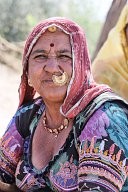
Portraits of women and children of Rajasthan. In the countryside, the women of Rajasthan wear long skirts, a small bolero and veil with bright colors. They adorn themselves with silver jewels ( earrings, nose rings, necklaces, arm and ankle bracelets). They raise the children and participate in the rural works ( cattle, farming, wood and water tasks). Most of the marriages are settled and the place of women is by and at the service of their in-laws.
Sandrine Huet / Le Pictorium
LePictorium_0146612.jpg
Pictures of Rajasthan, portraits and lifestyles
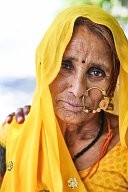
Portraits of women and children of Rajasthan. In the countryside, the women of Rajasthan wear long skirts, a small bolero and veil with bright colors. They adorn themselves with silver jewels ( earrings, nose rings, necklaces, arm and ankle bracelets). They raise the children and participate in the rural works ( cattle, farming, wood and water tasks). Most of the marriages are settled and the place of women is by and at the service of their in-laws.
Sandrine Huet / Le Pictorium
LePictorium_0146626.jpg
Pictures of Rajasthan, portraits and lifestyles
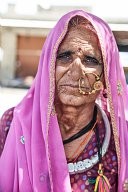
Portraits of women and children of Rajasthan. In the countryside, the women of Rajasthan wear long skirts, a small bolero and veil with bright colors. They adorn themselves with silver jewels ( earrings, nose rings, necklaces, arm and ankle bracelets). They raise the children and participate in the rural works ( cattle, farming, wood and water tasks). Most of the marriages are settled and the place of women is by and at the service of their in-laws.
Sandrine Huet / Le Pictorium
LePictorium_0146628.jpg
Pictures of Rajasthan, portraits and lifestyles
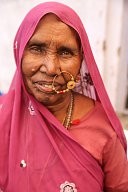
Portraits of women and children of Rajasthan. In the countryside, the women of Rajasthan wear long skirts, a small bolero and veil with bright colors. They adorn themselves with silver jewels ( earrings, nose rings, necklaces, arm and ankle bracelets). They raise the children and participate in the rural works ( cattle, farming, wood and water tasks). Most of the marriages are settled and the place of women is by and at the service of their in-laws.
Sandrine Huet / Le Pictorium
LePictorium_0146631.jpg
Pictures of Rajasthan, portraits and lifestyles
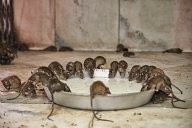
Karni Mata Temple, rat temple, Deshnok
Sandrine Huet / Le Pictorium
LePictorium_0146670.jpg
The temple at 30kms away from Bikaner is dedicated to the reincarnation of the goddess Durga, Karni Mata, the mother of miracles. Famous for the 10 000 rats living there, the temple is considered as the unique community of diurnal rats in the world. Seeing one of the rare white rats is a blessing and a manifestation of the Goddess herself. The rats are fed with milk and candies
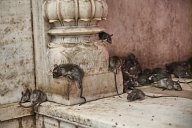
Karni Mata Temple, rat temple, Deshnok
Sandrine Huet / Le Pictorium
LePictorium_0146671.jpg
The temple at 30kms away from Bikaner is dedicated to the reincarnation of the goddess Durga, Karni Mata, the mother of miracles. Famous for the 10 000 rats living there, the temple is considered as the unique community of diurnal rats in the world. Seeing one of the rare white rats is a blessing and a manifestation of the Goddess herself. The rats are fed with milk and candies
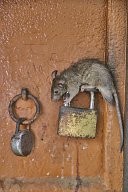
Karni Mata Temple, rat temple, Deshnok
Sandrine Huet / Le Pictorium
LePictorium_0146672.jpg
The temple at 30kms away from Bikaner is dedicated to the reincarnation of the goddess Durga, Karni Mata, the mother of miracles. Famous for the 10 000 rats living there, the temple is considered as the unique community of diurnal rats in the world. Seeing one of the rare white rats is a blessing and a manifestation of the Goddess herself. The rats are fed with milk and candies
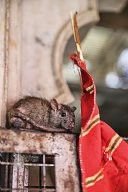
Karni Mata Temple, rat temple, Deshnok
Sandrine Huet / Le Pictorium
LePictorium_0146673.jpg
The temple at 30kms away from Bikaner is dedicated to the reincarnation of the goddess Durga, Karni Mata, the mother of miracles. Famous for the 10 000 rats living there, the temple is considered as the unique community of diurnal rats in the world. Seeing one of the rare white rats is a blessing and a manifestation of the Goddess herself. The rats are fed with milk and candies
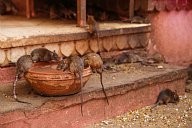
Karni Mata Temple, rat temple, Deshnok
Sandrine Huet / Le Pictorium
LePictorium_0146674.jpg
The temple at 30kms away from Bikaner is dedicated to the reincarnation of the goddess Durga, Karni Mata, the mother of miracles. Famous for the 10 000 rats living there, the temple is considered as the unique community of diurnal rats in the world. Seeing one of the rare white rats is a blessing and a manifestation of the Goddess herself. The rats are fed with milk and candies
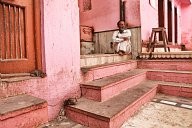
Karni Mata Temple, rat temple, Deshnok
Sandrine Huet / Le Pictorium
LePictorium_0146675.jpg
The temple at 30kms away from Bikaner is dedicated to the reincarnation of the goddess Durga, Karni Mata, the mother of miracles. Famous for the 10 000 rats living there, the temple is considered as the unique community of diurnal rats in the world. Seeing one of the rare white rats is a blessing and a manifestation of the Goddess herself. The rats are fed with milk and candies
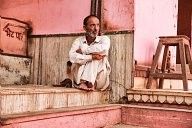
Karni Mata Temple, rat temple, Deshnok
Sandrine Huet / Le Pictorium
LePictorium_0146676.jpg
The temple at 30kms away from Bikaner is dedicated to the reincarnation of the goddess Durga, Karni Mata, the mother of miracles. Famous for the 10 000 rats living there, the temple is considered as the unique community of diurnal rats in the world. Seeing one of the rare white rats is a blessing and a manifestation of the Goddess herself. The rats are fed with milk and candies

Karni Mata Temple, rat temple, Deshnok
Sandrine Huet / Le Pictorium
LePictorium_0146677.jpg
The temple at 30kms away from Bikaner is dedicated to the reincarnation of the goddess Durga, Karni Mata, the mother of miracles. Famous for the 10 000 rats living there, the temple is considered as the unique community of diurnal rats in the world. Seeing one of the rare white rats is a blessing and a manifestation of the Goddess herself. The rats are fed with milk and candies
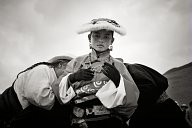
Faces beyond frontiers, Tibet
Sandrine Huet / Le Pictorium
LePictorium_0139566.jpg
Young Tibetan girl preparing for the traditional dance festival
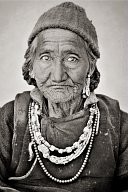
Faces beyond frontiers, Ladakh
Sandrine Huet / Le Pictorium
LePictorium_0139567.jpg
old Ladakhi woman in her working outfit

Tibet
Sandrine Huet / Le Pictorium
LePictorium_0139589.jpg
Horse Festival : Tibetan cultural festival of traditional dances and horse races in Chengso, Kham Province
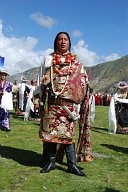
Tibet
Sandrine Huet / Le Pictorium
LePictorium_0139590.jpg
Horse Festival : Tibetan cultural festival of traditional dances and horse races in Chengso, Kham Province
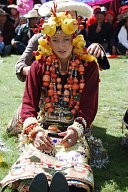
Tibet
Sandrine Huet / Le Pictorium
LePictorium_0139594.jpg
Horse Festival : Tibetan cultural festival of traditional dances and horse races in Chengso, Kham Province
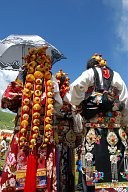
Tibet
Sandrine Huet / Le Pictorium
LePictorium_0139596.jpg
Horse Festival : Tibetan cultural festival of traditional dances and horse races in Chengso, Kham Province

Tibet
Sandrine Huet / Le Pictorium
LePictorium_0139597.jpg
Horse Festival : Tibetan cultural festival of traditional dances and horse races in Chengso, Kham Province

